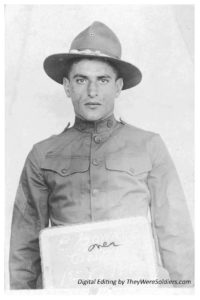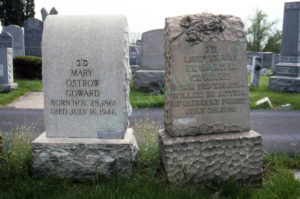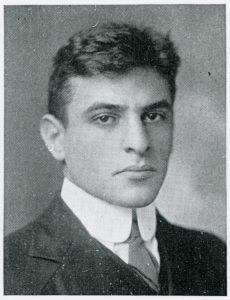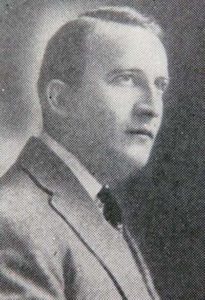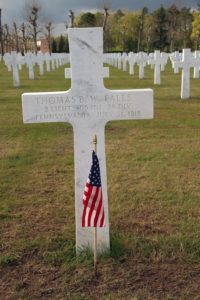In a prior post, I told the story of Sergeant Irving Sydney Clair, who, while serving in the United States 28th “Keystone” Infantry Division, was badly wounded in mid-July of 1918. Though completely blinded, he survived the war, only ironically to pass on from illness in early 1919, in the United States. Unlike many other Jewish WW I soldiers profiled at this blog, his story could be related here in “full” – at least, compared to that of other Jewish WW I military casualties – principally by virtue of a lengthy news article that appeared in the New York (Albany, to be specific) newspaper The Argus in December of 1918, as secondarily via articles in newspapers serving southeastern Pennsylvania.
I related Sergeant Clair’s story in the context of a series of blog posts covering the military service of American Jewish soldiers during the First World War. These comprise a general overview of the military service of American Jewish soldiers during that conflict, through coverage of this in the general and Jewish news media (in three parts – here, here, and here); via photographic portraits of American Jewish WW I soldiers from the state of Pennsylvania who were military casualties (here, here, and here); and, by means of biographical profiles of American Jewish soldiers who were military casualties on Armistice Day; November 11, 1918.
Another Jewish soldier whose life and military service can be recounted in detail (at least, relative detail) was like Sergeant Clair also a Philadelphian: He was First Lieutenant Edward Benjamin Goward, Company Commander of M Company, 110th Infantry Regiment, 28th Infantry Division. The son of George and Mary (Astro) Goward, 1616 North Marshall St., Philadelphia, Pa., he was born in that city on September 15, 1894. A graduate of the University of Pennsylvania (class of 1916), he’d previously served on the Mexican border.
____________________
Shoulder sleeve insignia of the 28th Infantry Division. Though this specific patch dates from the Second World War, the insignia has remained unchanged since the design’s creation in 1918.
____________________
On July 29, 1918, while leading his troops, Lieutenant Goward was mortally wounded by a sniper. His second-in-command, Lieutenant Thomas B.W. Fales (also a Philadelphian) immediately came to his aid, but Lt. Fales, as well, was shot – also mortally wounded – by the same sniper. Seeing the plight of the two officers, Sergeant Howard L. Barnes in turn went to help, but he, too, was shot. Fortunately, Sergeant Barnes survived his wounds. He passed away at the age of 71, in the year 1954: In another time, and, within terms real and symbolic, an entirely different United States.
Lieutenant Goward was buried at Montefiore Cemetery, in Jenkintown, Pennsylvania, on January 18, 1922 (Section E, Lot 1, Grave 3) (Lieutenant Fales rests at the Oise-Aisne American Cemetery, at Seringes-et-Nesles, France.) News articles about him appeared in the Evening Public Ledger (9/6/18 and 5/15/19), and Philadelphia Inquirer (9/7/18, 10/27/18, and 1/19/22). Curiously, his name is absent from Haulsey, Howe, and Doyle’s 1920 Soldiers of the Great War – Memorial Edition.
This posts presents transcripts of news articles about Lieutenants Goward and Fales in chronological order.
I’d initially hesitated in presenting this sad story in its full detail, but, realizing that it’s better to have a story told, than forgotten, it fully follows below…
____________________
Here’s Lieutenant (at the time, Sergeant) Goward’s portrait from his Pennsylvania WW I Veterans Compensation File.
____________________
7 City Soldiers Dead and 7 Hurt
Five Army Lieutenants From This Section Among Casualties
Evening Public Ledger and The Evening Telegraph
Friday, September 6, 1918
Seven more Philadelphians have been added to the heroes from this city who have given their lives for the country on the battlefields of France.
The death of two Philadelphia Lieutenants – Edward B. Goward and Thomas B. Fales – are reported unofficially in a letter written by a soldier in France. The reports are confirmed by an officer who has returned here from France and is now in this city.
Lieutenant Goward was killed while acting commander of Company M, 109th Infantry, formerly the First Pennsylvania, and Lieutenant Fales was second in command. Both men were reported wounded on July 30 last, but the official casualty lists from Washington have as yet made no mention of their names.
The author of the letter, Supply Sergeant Charles McFadden, 2nd, also asserts in his latest letter that the Old First was virtually wiped out – that of twelve infantry companies hardly enough men were left to make up one company.
“When this letter reaches you, the State of Pennsylvania will be in mourning,” he wrote.
Sketches of Heroes
Lieutenant Thomas B. Fales, widely known cricketer and a nephew of John Wanamaker, fell at the head of his company, according to an official report received here today. He is said to have been shot six times, once through the lungs and five times through the abdomen.
The report of his death is contained in a letter received here by Charles McFadden, Jr., 4032 Walnut Street, from his son, Charles McFadden, 3rd, a supply sergeant of Company M, 109th Infantry. The report of his death and that of Lieutenant Goward is confirmed by Lieutenant William Stephenson, 1449 Cayuga Street, of Company I, who is now in this city to act as an instructor.
Lieutenant Fales, who is the son of the late Mrs. Mary W. Fales, 4407 Spruce Street, was cited for valor on the battlefield during the defense of the Marne about the middle of July.
Lieutenant Fales was thirty-two years old and a graduate of the University of Pennsylvania. Before enlisting he was a member of the firm of Fales & Dutcher.
He was reported wounded on July 30; his family received word to that effect from letters written here by members of his company. They were unable to confirm the report in Washington. Neither his name nor that of Lieutenant Goward has appeared in the official casualty list.
Lieutenant Edward B. Goward, 1618 North Marshall Street, was a newspaper man of this city before he enlisted in the service. Information to the effect that he was killed is contained in the letters received by Mr. McFadden from his son. Writing of the death of Lieutenant Goward, Sergeant McFadden said:
“He was put in command of our company, with Lieutenant Fales, a pal of mine from the officers’ training school, as second in command. After two days of fighting through the woods, we had to advance down a hill, across a small river and up another hill, all in the open.
“The boche were entrenched around the edge of a wood, with a bunch of machine guns and he gave us h___, we took the woods, but in doing so Lieutenants Goward and Fales were killed.
“Goward was hit once in each shoulder and a couple of times in the stomach. If his name is published in the papers, tell dad to call up his father and tell him that Eddie died at the head of his men and that his men would have gone through h___ for him.
“He was considered one of the bravest men in the regiment and had a very rosy future before him. He is buried where he fell, on the side of a hill near Courmant.
“Our American graves are marked with a small wooden cross, with the soldier’s identification tag tacked on it. Fales was killed and buried near the same place.”
Lieutenant Goward was reported wounded in action on July 30 in a former letter received from Sergeant McFadden. The War Department has no confirmation of the report of Lieutenant Goward having been wounded.
The last letter received from the lieutenant by his mother, Mrs. Mary Goward, said he had been acting as forward observing officer “in a busy sector,” but had been relieved and was then in the rear. This was before the time fixed by Sergeant McFadden as the day when he was killed.
____________________
Sons of State Disregarded All Hazards to Crush Foe
French Commander Lauds Pennsylvanians for Remarkable Record Made After Reaching Vesle River
Evening Public Ledger – Philadelphia
Thursday, May 15, 1919
Thomas W. Fales, a Philadelphia boy and lieutenant in M Company, 109th Infantry, gave up his life in the fighting at Courmont, on July 29. His commander, Lieutenant Edward B. Goward, went forward forty yards to reconnoiter and was hit in the head by a sniper’s bullet. Lieutenant Fales crawled out to his rescue. A German bullet hit him in the head. Sergeant Howard L. Barnes, seeing the plight of his two superiors, crawled out to rescue them, but met a similar fate.
Sergeant Walter Miller was more fortunate in the rescue work and reached the trio without getting hit. Lieutenants Fales and Goward refused assistance and ordered Miller to carry Sergeant Barnes to the rear. He obeyed the command. Fales and Goward died before their company reached them.
____________________
Philadelphia Inquirer
September 7, 1918 or October 27, 1918
The death in action of Second Lieutenant Goward, Company M, 109th Infantry, has finally been confirmed by the War Department.
The confirmation shatters the unyielding hope which possessed the young officer’s mother, Mrs. Mary Goward, 1616 North Marshall Street, from the first report that he had been killed.
Lieutenant Goward died at the head of his platoon in an attack on a machine gun nest in a woods south of the Curcq River on July 29.
To his comrades he was known as an heroic officer and soldier with a personal disregard of self and a supreme contempt for German bullets.
He and Lieutenant Thomas G.W. Fales, led the charge which cleared out the machine gun nest. Lieutenant Fales, too, fell on that eventful day, and the War Department has as yet given no information to his parents at 4407 Spruce Street.
Both men had come unscathed through the terrific fighting south of the Marne River when M Company of the 109th Infantry, was cut off and almost annihilated. Lieutenant Fales at that time won a citation for the way in which he rallied a few survivors and took them back to the regiment. Lieutenant Goward was serving as a sergeant in the headquarters company at the time, he having not yet received his commission, which was won at the Third Officers’ Training Camp at Fort Hancock. After July 15 he was assigned to M Company under Lieutenant Fales.
Lieutenant Goward was a graduate of the University of Pennsylvania, where he won the Latin prize, and enlisted in the old First Regiment of the National Guard at the outbreak of the war. The War Department confirmation of his death, said tersely: –
“We regret to inform you that Lieutenant E.G. Goward, infantry, was killed in action, July 19.”
____________________
LIEUT. THOMAS FALES KILLED IN FRANCE
Man Who Met Death of a Hero in France Engaged to Marry Miss Ethel Badgley
Word was received today by Rev. and Mrs. J.T. Badgley that Lieut. Thomas B.W. Fales, of Philadelphia, who was engaged to marry their daughter, Ethel, has been killed in action in France on July 30, in the fiercest of fighting. He was shot six times, once through the lungs and five times through the abdomen. Word came through a letter written by Miss Badgley at the Fales home in Philadelphia.
Lieutenant Fales and another young officer of Co. M., 109th Infantry, who also was killed, were leading a charge against the Germans when they made the supreme sacrifice.
Information of their death was received from comrades and later confirmed by a letter from Lieut. Wilson Stephenson, of Co. M, of Philadelphia. The names of the two dead officer have not yet been listed with the official casualties, but a number of letters have been received by relatives telling of their deaths together with some of the details, leaving no doubt of the truth.
One of the comrades of the two men in writing about their death spoke of their bravery and declared that the regiment had almost been wiped out – that of the twelve companies hardly enough men had been left to make on full company. Lieutenant Fales was officially reported as wounded a week ago, but later this was officially denied.
Lieutenant Fales was thirty-two years old and was a nephew of John Wanamaker. He was a graduate of the University of Pennsylvania and at one time was widely known as a cricket player. He also was a fullback on the soccer teams in 196 and 1917.
At almost the beginning of the Allied drive in July along the Marne, he was mentioned in the despatches for his gallantry in leading a party of men out of a desperate situation when they got too far advanced. The regiment of which Lieutenant Fales was a member was in the thickest of the fight and is said to have been the means of turning the ride in a fierce fight in which the Germans were pushing the Allies.
Miss Badgley and Lieutenant Fales met in Philadelphia about three years ago at the wedding of the latter’s brother and their acquaintanceship later ripened into love and about a year ago their engagement was announced.
____________________
Here’s Lieutenant Goward’s War Service Record, as completed by his mother in June of 1919…
Enlisted as Private
During summer of 1916 located at El Paso Texas
Discharged October 1916.
Called back to service March 1917. Guard duty in vicinity of Harrisburg.
Camp Hancock September 1917 until April 1918.
Camp Upton from April 26th, 1918 until May 2nd, 1918.
France from May 1918 until his death in action July 29th 1918.
July 1916 Corporal
March 1917 Sergeant
Top Sergeant December 1917
Second Lieutenant, July 1918
First Lieutenant, end of July
Acting Captain of Co. M. 109th
Lieut. Goward was killed in action July 29th, 1918, while leading Co. M. of 109th. The details may be obtained from the accompanying newspaper account. He is buried in a cemetery at Courmont, France.
____________________
The matzevot of Lieutenant Goward and his mother, at Montefiore Cemetery, Philadelphia, Pa…
…and, the title page of The Record – the Class Yearbook for the University of Pennsylvania – for the class of 1916…
 …within which, an entry for Edward Goward appears on page 49…
…within which, an entry for Edward Goward appears on page 49…
…while here’s his portrait.
____________________
This portrait of Thomas B.W. Fales as a civilian – his University of Pennsylvania graduation portrait, as well? – is via FindAGrave contributor Robert Sage…
…while this picture of his tombstone, at the Oise-Aisne American Cemetery and Memorial, in Picardie, France, is via Linkert.
____________________
According to the May 15, 1919, issue of the Philadelphia Evening Public Ledger – Philadelphia, “Sergeant Howard L. Barnes, seeing the plight of his two superiors, crawled out to rescue them, but met a similar fate.” But, this sentence is quite ambiguous and open to different interpretations, for it does not specify what his “fate” actually was. Was Sergeant Barnes killed? Did he survive? If so, how badly wounded was he?
Documents in his Veteran’s Compensation File reveal the answer: Sergeant Howard Logan Barnes, although badly wounded by a sniper, did survive the war. Though this “Immediate Report of Death” (a one-page form not uncommonly found among documents pertaining to soldiers who were killed in action, or died of wounds) indicates that he died some time between July 28 and 31, 1918…
…another very brief document (not illustrated in this post; it’s as physically small as it is brief) simply states that he was wounded in the right elbow and right thigh.
Sergeant Barnes’ survival is further and solidly attested to by this Abstract of Military Service which, though it lists a very incorrect date when he was wounded (not October 26!), verifies his survival.
And finally, we have a Soldiers’ and Sailors’ Honor Roll record completed by the Sergeant’s mother in March of 1919, in which information about the July incident is absent.
And last, a quick check of FindAGrave reveals that Howard Barnes – born in Wayne County, Pa., on April 15, 1894, passed away in that locale on November 17, 1954, at the age of 71. He’s buried at Fairview Memorial Park, in Lackawanna County.


